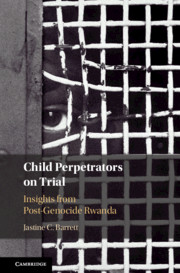Book contents
- Child Perpetrators on Trial
- Child Perpetrators on Trial
- Copyright page
- Epigraph
- Contents
- Foreword
- Preface and Acknowledgements
- Abbreviations
- 1 Introduction
- 2 International Standards on Child Perpetrators of Atrocities
- 3 Putting International Standards into Practice
- 4 Rwanda: Setting the Context
- 5 Rwanda’s Responses, in Law, Policy and Practice, to Child Génocidaires
- 6 International Actors and the Rwandan Child Génocidaire
- 7 UNICEF Rwanda’s Policy and Advocacy: A Strategic Approach
- 8 Evaluating UNICEF Rwanda’s Approach
- 9 Child Perpetrators and Child Rights: Rwanda and Beyond
- Book part
- Bibliography
- Index
2 - International Standards on Child Perpetrators of Atrocities
Published online by Cambridge University Press: 18 October 2019
- Child Perpetrators on Trial
- Child Perpetrators on Trial
- Copyright page
- Epigraph
- Contents
- Foreword
- Preface and Acknowledgements
- Abbreviations
- 1 Introduction
- 2 International Standards on Child Perpetrators of Atrocities
- 3 Putting International Standards into Practice
- 4 Rwanda: Setting the Context
- 5 Rwanda’s Responses, in Law, Policy and Practice, to Child Génocidaires
- 6 International Actors and the Rwandan Child Génocidaire
- 7 UNICEF Rwanda’s Policy and Advocacy: A Strategic Approach
- 8 Evaluating UNICEF Rwanda’s Approach
- 9 Child Perpetrators and Child Rights: Rwanda and Beyond
- Book part
- Bibliography
- Index
Summary
Individuals who have committed atrocities may be tried by national courts for international crimes or for ordinary crimes (the underlying offence). Children who come into conflict with the law are accorded special protection under international human rights law which goes beyond the protection provided to adults. Chapter 2 provides a detailed review of international juvenile justice standards, in particular those contained in the CRC, pertaining to children who come into conflict with the law generally. These include minimum procedural guarantees, restrictions on sanctions, and the requirement on states to establish a minimum age of criminal responsibility, put in place juvenile-specific laws, procedures and institutions, and act in the best interests of the child. The focus then shifts to child perpetrators of international crimes. The chapter considers briefly whether children can be prosecuted for international crimes, analysing international criminal law and practice and the treaties that require states to prevent and punish core international crimes. After establishing that children can be prosecuted for international crimes, the chapter argues that a child who is accused of committing genocide, or any other international crime, is entitled to the same rights and protections as a child who has committed an ordinary crime.
Keywords
- Type
- Chapter
- Information
- Child Perpetrators on TrialInsights from Post-Genocide Rwanda, pp. 21 - 47Publisher: Cambridge University PressPrint publication year: 2019

